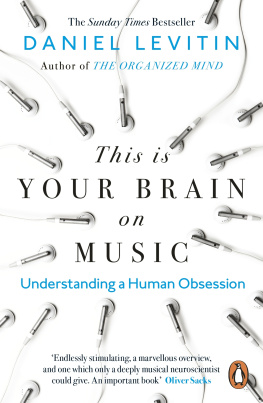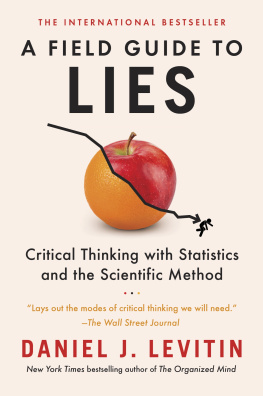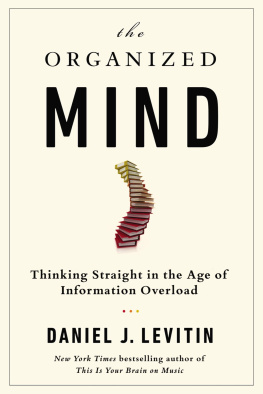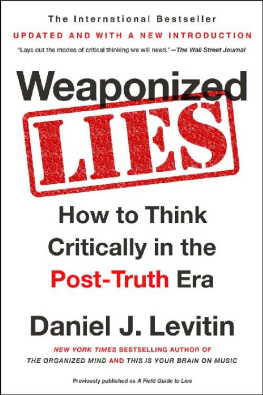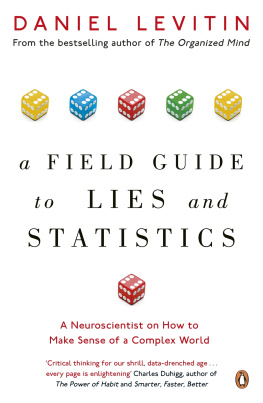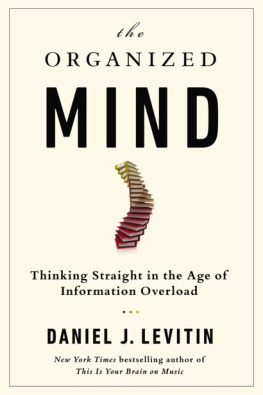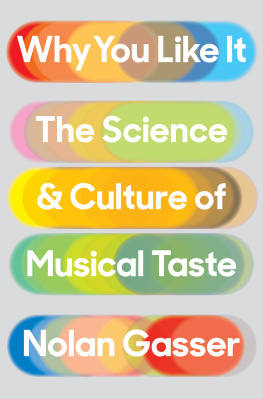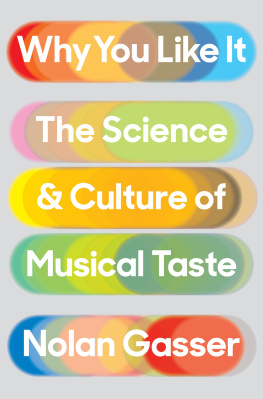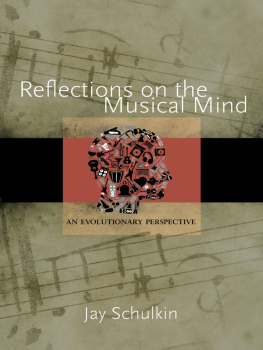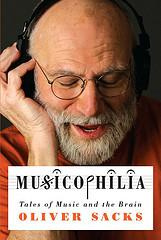

Contents
Daniel Levitin
THIS IS YOUR BRAIN ON MUSIC
Understanding a Human Obsession

PENGUIN BOOKS
UK | USA | Canada | Ireland | Australia
India | New Zealand | South Africa
Penguin Books is part of the Penguin Random House group of companies whose addresses can be found at global.penguinrandomhouse.com.

First published in the United States of America by Dutton, a member of Penguin Group (USA) Inc. 2006
First published in hardback in Great Britain by Atlantic Books, an imprint of Grove Atlantic Ltd. 2007
Published in Penguin Books 2019
Copyright Daniel Levitin, 2006
The moral right of the author has been asserted
Cover design by Mecob. Cover image Thomas Vogel / Getty Images
Every effort has been made to trace or contact all copyright holders. The publishers will be pleased to make good any omissions or rectify any mistakes brought to their attention at the earliest opportunity
ISBN: 978-0-241-98736-0
This ebook is copyright material and must not be copied, reproduced, transferred, distributed, leased, licensed or publicly performed or used in any way except as specifically permitted in writing by the publishers, as allowed under the terms and conditions under which it was purchased or as strictly permitted by applicable copyright law. Any unauthorized distribution or use of this text may be a direct infringement of the authors and publishers rights and those responsible may be liable in law accordingly.

THE BEGINNING
Let the conversation begin
Follow the Penguin twitter.com/penguinukbooks
Keep up-to-date with all our stories youtube.com/penguinbooks
Pin Penguin Books to your pinterest.com/penguinukbooks
Like Penguin Books on facebook.com/penguinbooks
Listen to Penguin at soundcloud.com/penguin-books
Find out more about the author and
discover more stories like this at penguin.co.uk
About the Author
Dr. Daniel J. Levitin has a PhD in Psychology, training at Stanford University Medical School and the University of California, Berkeley. He is the author of the No. 1 bestseller This Is Your Brain on Music (Dutton, 2006), published in nineteen languages, and the bestsellers The World in Six Songs (Dutton, 2008) and The Organized Mind (Viking, 2014). Currently he is a James McGill Professor of Psychology, Behavioral Neuroscience and Music at McGill University in Montreal, Canada.
Introduction
I Love Music and I Love ScienceWhy Would I Want to Mix the Two?
I love science, and it pains me to think that so many are terrified of the subject or feel that choosing science means you cannot also choose compassion, or the arts, or be awed by nature. Science is not meant to cure us of mystery, but to reinvent and reinvigorate it.
Robert Sapolsky, Why Zebras Dont Get Ulcers, p. xii
In the summer of 1969, when I was eleven, I bought a stereo system at the local hi-fi shop. It cost all of the hundred dollars I had earned weeding neighbors gardens that spring at seventy-five cents an hour. I spent long afternoons in my room, listening to records: Cream, the Rolling Stones, Chicago, Simon and Garfunkel, Bizet, Tchaikovsky, George Shearing, and the saxophonist Boots Randolph. I didnt listen particularly loud, at least not compared to my college days when I actually set my loudspeakers on fire by cranking up the volume too high, but the noise was evidently too much for my parents. My mother is a novelist; she wrote every day in the den just down the hall and played the piano for an hour every night before dinner. My father was a businessman; he worked eighty-hour weeks, forty of those hours in his office at home on evenings and weekends. Being the businessman that he was, my father made me a proposition: He would buy me a pair of headphones if I would promise to use them when he was home. Those headphones forever changed the way I listened to music.
The new artists that I was listening to were all exploring stereo mixing for the first time. Because the speakers that came with my hundred-dollar all-in-one stereo system werent very good, I had never before heard the depth that I could hear in the headphonesthe placement of instruments both in the left-right field and in the front-back (reverberant) space. To me, records were no longer just about the songs anymore, but about the sound. Headphones opened up a world of sonic colors, a palette of nuances and details that went far beyond the chords and melody, the lyrics, or a particular singers voice. The swampy Deep South ambience of Green River by Creedence, or the pastoral, open-space beauty of the Beatles Mother Natures Son; the oboes in Beethovens Sixth (conducted by Karajan), faint and drenched in the atmosphere of a large wood-and-stone church; the sound was an enveloping experience. Headphones also made the music more personal for me; it was suddenly coming from inside my head, not out there in the world. This personal connection is ultimately what drove me to become a recording engineer and producer.
Many years later, Paul Simon told me that the sound is always what he was after too. The way that I listen to my own records is for the sound of them; not the chords or the lyricsmy first impression is of the overall sound.
I dropped out of college after the incident with the speakers in my dorm room, and I joined a rock band. We got good enough to record at a twenty-four-track studio in California with a talented engineer, Mark Needham, who went on to record hit records by Chris Isaak, Cake, and Fleetwood Mac. Mark took a liking to me, probably because I was the only one interested in going into the control room to hear back what we sounded like, while the others were more interested in getting high in between takes. Mark treated me like a producer, although I didnt know what one was at the time, asking me what the band wanted to sound like. He taught me how much of a difference to the sound a microphone could make, or even the influence of how a microphone was placed. At first, I didnt hear some of the differences he pointed out, but he taught me what to listen for. Notice that when I put this microphone closer to the guitar amp, the sound becomes fuller, rounder, and more even; but when I put it farther back, it picks up some of the sound of the room, giving it a more spacious sound, although you lose some of the midrange if I do that.
Our band became moderately well known in San Francisco, and our tapes played on local rock radio stations. When the band broke updue to the guitarists frequent suicide attempts and the vocalists nasty habit of taking nitrous oxide and cutting himself with razor bladesI found work as a producer of other bands. I learned to hear things I had never heard before: the difference between one microphone and another, even between one brand of recording tape and another (Ampex 456 tape had a characteristic bump in the low-frequency range, Scotch 250 had a characteristic crispness in the high frequencies, and Agfa 467 a luster in the midrange). Once I knew what to listen for, I could tell Ampex from Scotch or Agfa tape as easily as I could tell an apple from a pear or an orange. I progressed to work with other great engineers, like Leslie Ann Jones (who had worked with Frank Sinatra and Bobby McFerrin), Fred Catero (Chicago, Janis Joplin), and Jeffrey Norman (John Fogerty, the Grateful Dead). Even though I was the producerthe person in charge of the sessionsI was intimidated by them all. Some of the engineers let me sit in on their sessions with other artists, such as Heart, Journey, Santana, Whitney Houston, and Aretha Franklin. I got a lifetime of education watching them interact with the artists, talking about subtle nuances in how a guitar part was articulated or how a vocal performance had been delivered. They would talk about syllables in a lyric, and choose among ten different performances. They could hear so well; how did they train their ears to hear things that mere mortals couldnt?
Next page
